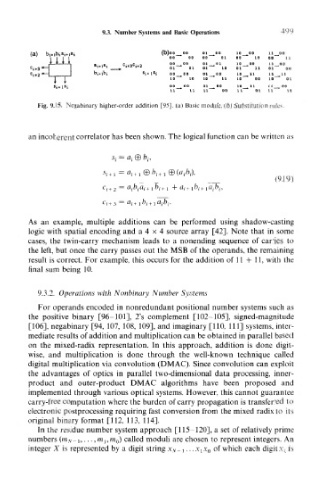Page 514 - Introduction to Information Optics
P. 514
9.3. Number Systems and Basic Operations 499
00 01 10
(a) bi+ibi^jiiai {")°° > ,"° ,'" u
v
1 1 I i oo"~* oo oo 01 oo 10 oo"
01 B1 10 OD il
_t__i—i_jL a a c- *c- ? 2 °° °°
'*' * » l ** 01 01 01 10 01 11 01"
bi*ibi *i+i*i oo__^oo 01 _^oo i"_^ii n
io~* 10 10 ~* 11 10 * OB 10
oo 11 01 11
Fig, 9.15, Negabinary higher-order addition [95]. (a) Basic module, (b) Substitution rules.
an incoherent correlator has been shown. The logical function can be written as
'i "i VL/ ^i-
a 1 - > .
i+1 i +
As an example, multiple additions can be performed using shadow-casting
logic with spatial encoding and a 4 x 4 source array [42]. Note that in some
cases, the twin-carry mechanism leads to a nonending sequence of carries to
the left, but once the carry passes out the MSB of the operands, the remaining
result is correct. For example, this occurs for the addition of 11 + 11, with the
final sum being 10.
9.3.2. Operations with Nonbinary Number Systems
For operands encoded in nonredundant positional number systems such as
the positive binary [96-101], 2's complement [102-105], signed-magnitude
[106], negabinary [94, 107, 108, 109], and imaginary [110, 111] systems, inter-
mediate results of addition and multiplication can be obtained in parallel based
on the mixed-radix representation. In this approach, addition is done digit-
wise, and multiplication is done through the well-known technique called
digital multiplication via convolution (DMAC). Since convolution can exploit
the advantages of optics in parallel two-dimensional data processing, inner-
product and outer-product DMAC algorithms have been proposed and
implemented through various optical systems. However, this cannot guarantee
carry-free computation where the burden of carry propagation is transferred to
electronic postprocessing requiring fast conversion from the mixed radix to its
original binary format [112, 113, 114].
In the residue number system approach [115-120], a set of relatively prime
numbers (m N_ j,..., w t , m 0) called moduli are chosen to represent integers. An
integer X is represented by a digit string x v ~ i. . - x {x 0 of which each digit .x r is

